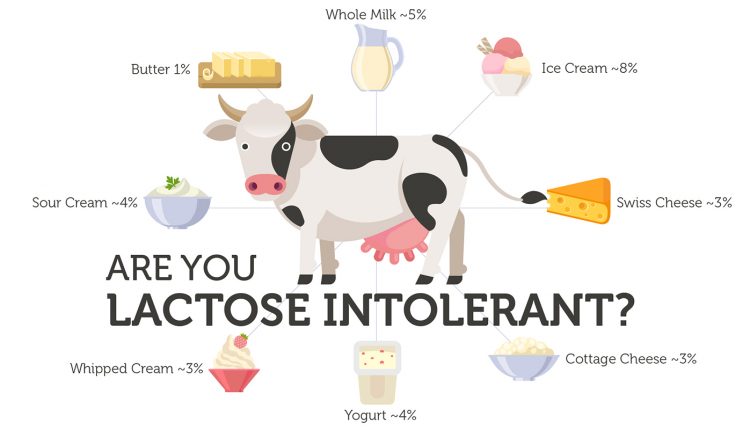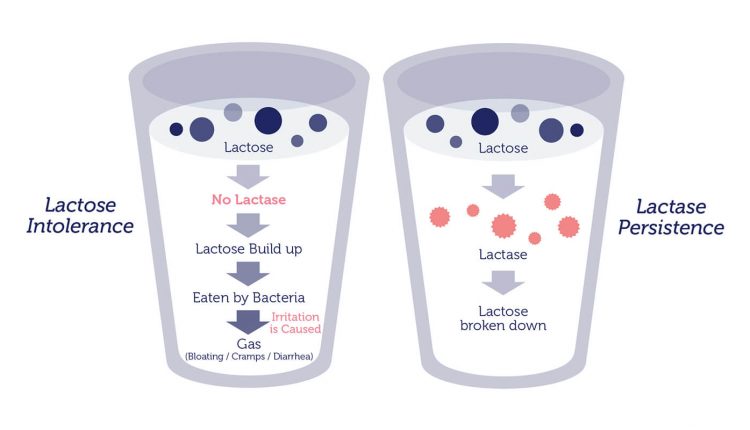Does milk give you gas? A novel product may be the solution.
by Susan Burke March
Humans have enjoyed cow’s milk for more than 7,500 years, after a genetic change enabled Europeans to consume cow’s milk without getting sick. It is theorized that natural selection promoted the survival of those peoples who are able to digest lactose, the carbohydrate in milk.
As reported in ScienceDaily.com, being able to drink milk is an evolutionary advantage. “Milk provides a calorie-and protein-rich food source, comes in relatively constant supply compared to the boom-and-bust of seasonal crops, and would have been less contaminated than water” thus supporting human development and advancement.

All milk, from cow’s, sheep, goats, and humans, is a combination food, and contains all major nutrients — protein, carbohydrate, and fat — all in one cup (237 ml or 240 g). Milk is also naturally rich in calcium – one serving contains 300 mg, about 30 percent of the recommended daily allowance for most adults. It also has 18 percent of the recommendation for vitamin B12, some vitamin A and B6, and potassium and magnesium. Most commercially sold cow’s milk is enriched with vitamin D, which makes the calcium much more absorbable. If it is reduced or nonfat, vitamin A is added as well.
Lactose intolerance vs. milk allergy
Lactose, or milk sugar, is the carbohydrate in milk. In order to absorb lactose, humans make the enzyme lactase in the small intestine.
Lactose intolerance is caused by a deficiency of lactase. Intolerance typically causes digestive problems like bloating, gas, or diarrhea soon after consuming lactose, but symptoms may occur up to two hours after consuming milk or products containing milk, regardless of the source ‑— from a cow, goat, sheep, yak, or camel. For some, a small amount of lactose is possible, but more than a half-cup produces symptoms.

Milk allergy is a true food allergy caused by an allergic reaction to the protein in milk. An allergy to milk is quite rare and will produce symptoms after consuming any type of dairy. Symptoms may start within seconds, or a few minutes, or up to a few hours. They can range from hives, wheezing, itching or tingling around the mouth, to a dangerous swelling of lips, tongue or throat, coughing or shortness of breath, and vomiting.
Researchers note that although most mammals make little lactase after weaning, many human cultures have evolved to have lactase persistence. For example, only 17 percent of Greeks and 14 percent of Sardinians continue to make lactase into adulthood, but 80 percent of Finns and Hungarians and 100 percent of Irish people are lactase persistent and enjoy milk without any problem.

But, suppose you don’t have an allergy or intolerance, but still have symptoms when you drink cow’s milk? You know you’re not lactose intolerant because you can enjoy milk (or cheese) from sheep or goats. And just to be sure about cow’s milk, you’ve tried lactose-free cow’s milk and you’ve tried adding lactase drops to your milk or even taking lactase by mouth before eating cheese or drinking milk, and you still get gas.
Now there may be an option: A2 milk from A2 cows.
As reported in MedicalDaily.com, “Normal cow’s milk contains both A1 and A2 variants of the beta-casein protein, one of the six produced by the CSN2 gene. Some believe that A1, which is only different from A2 by one slight amino acid variation, is harder to digest and can cause discomfort in people who are intolerant to milk.
International Milk Genomics Consortium writes that all mammals’ milk contains a mix of proteins, from casein (80 percent) and from whey. A1 and A2 proteins are from the casein family and are digested differently. A1 protein-digestion releases a peptide called BCM-7. The theory is that A2 cow’s milk is more easily digested because it doesn’t release this peptide. Milk from other mammals including human, goat, sheep, and yes, camel milk is predominantly A2.
The secret is in the cows
The secret to making A2 milk is in the cows. Holstein breeds, usually found in America and some European countries, contain both A1 and A2 proteins, while animals from Asian, African and Jersey and Guernsey (from the Channel Islands) have predominantly A2 .
Holstein carries the lowest proportion of A2 protein, only 35 percent. Brown Swiss carry about 70 percent A2, and other breeds about 50 percent.

The New Zealand-based a2 Milk Company owns the patent to the method for identifying the A2 milk cows, meaning it has been the only brand that can sell milk with the A2 label. This trademarked brand is currently found in stores in Australia, New Zealand, USA, UK, China, Singapore, and Hong Kong. I corresponded with the company via their Facebook page and they confirm that they are not yet testing cows or producing genetically certified A2 milk in Latin America.
Leche en Ecuador
According to FoodNewsLatam.com, Ecuador has a census of around 4.6 million head of cattle, with more than a million milked daily. Most cows are concentrated in the province of Manabí, and the herds are mostly Holstein, Jersey, and Brown Swiss.
The Latin American “native” Criollo (or Creole) cattle, a group of cattle breeds descended from Spanish stock imported to the Americas, make up about 30 percent of cows throughout Ecuador. Over the centuries these hardy cows have been crossbred with others. Whether or not their milk is predominantly A1 or A2 is unknown.
Rob Gray, of Gran Roca Sustainable Farm in Yunguilla Valley, says, “One of my partners is Ecuadorian and raises milk cows. Although Criollos are fine for a family, they don’t produce enough milk to be used for the dairy business.” Rob suggested that farmers with Criollos typically breed their females with better milk producers including Jerseys, Holsteins, and Brown Swiss to produce better milk producers. Rob also reminds us that milk processors generally collect milk from a number of small farmers, making it unlikely to find exclusively A2 milk in Ecuador. And we’d need the genetic test to be sure, and it is not yet available.
Miguel Mejia Pacheco is from a family of dairy farmers in Chilla, southwest of Santa Isabel. Currently completing his degree in Veterinary Studies at Universidad Politécnica Salesiana, Miguel says that in Ecuador the location of the livestock — on the coast, in the Andes, or the south, determines the predominant breed. Here in the Andes, the most common are Holstein Friesian, Jersey, and Brown Swiss; on the coast. Brahma, Zebu, and the Girolando predominate. Girolando is a breed of dairy cattle created in Brazil by crossing Gyr cattle (an Indian native breed that produces A2 milk) with Holstein cows, which give mainly A1.

Ganado Criollo de Manabí
Other considerations
a2 Milk™ is costly. To find out more, I placed a call to a Publix Supermarket, in Deerfield Beach, Florida, to inquire about a2 Milk™ milk. A ½ gallon of 2% reduced fat a2 Milk™ (1.89 liter) sells for $4.49. The Publix brand of conventional 2% milk costs $1.18; Horizon brand Organic 2% milk was on sale for $3.99 for the half-gallon, but typically costs $4.49 as well.
[By the way, a2 Milk™ milk is not necessarily organic. On the company’s website, they state that some farmers and processors do “follow organic principles” but some do not.]
What does the science say?
Does the science back up the claims? The a2 Milk™ website has a whole section devoted to testimonials but the plural of anecdote is not data. In an article from the International Milk Genomics organization, it is noted that the mainly small published studies are mostly conducted by the a2 Milk™ company. The IMG writes, “The science of A2 milk is still in its infancy. Any scientific claim with only a handful of studies behind it (particularly those with a conflict of interest in the study outcome or questions regarding the data) should always be couched in the language of “emerging evidence” rather than “conclusive findings”.
The Takeaway
The evidence is currently inconclusive, but it is possible that people who have stopped drinking regular cow’s milk due to digestive discomfort may be able to tolerate A2 milk. If you are not lactose intolerant and you can enjoy sheep or goat or camel milk (yes, you can buy it in the USA), when you visit the USA or other countries where they sell a2 Milk™, give it a try. And let me know!
Sources
BMC Evolutionary Biology. A worldwide correlation of lactase persistence phenotype and genotypes.
FoodNewsLatam.com Manabí Creole cattle with a predisposition toward dairy production.
MedicalDaily.com. A2 MILK™ ™ milk has become trendy, but is it actually better?
MidwestDairy.com. Dairy Breeds.
MilkGenomics.org. What’s in the Dairy Case? A2 MILK™ ™ Milk.
National Institutes of Health U.S. National Library of Medicine. Genetics Home Reference. Lactose Intolerance.
ScienceDaily.com. Milk drinking started around 7,500 years ago in Central Europe.





















